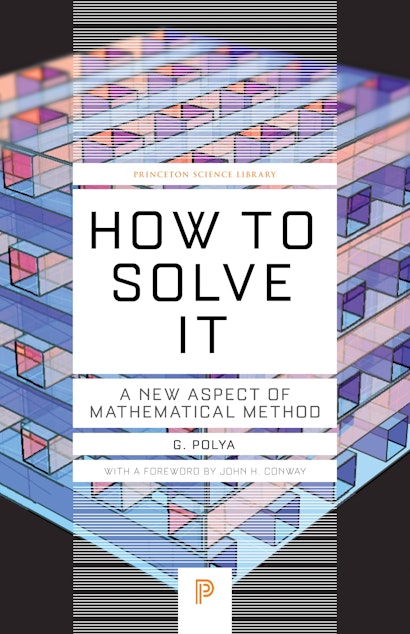A must-have guide by eminent mathematician G. Polya, How to Solve It shows anyone in any field how to think straight. In lucid and appealing prose, Polya reveals how the mathematical method of demonstrating a proof or finding an unknown can help you attack any problem that can be reasoned out—from building a bridge to winning a game of anagrams. How to Solve It includes a heuristic dictionary with dozens of entries on how to make problems more manageable—from analogy and induction to the heuristic method of starting with a goal and working backward to something you already know.
This disarmingly elementary book explains how to harness curiosity in the classroom, bring the inventive faculties of students into play, and experience the triumph of discovery. But it’s not just for the classroom. Generations of readers from all walks of life have relished Polya’s brilliantly deft instructions on stripping away irrelevancies and going straight to the heart of a problem.
"Every prospective teacher should read it. In particular, graduate students will find it invaluable. The traditional mathematics professor who reads a paper before one of the Mathematical Societies might also learn something from the book: 'He writes a, he says b, he means c; but it should be d.'"—E. T. Bell, Mathematical Monthly
"[How to Solve It] shows anew how keen its author is on questions of method and the formulation of methodological principles. Exposition and illustrative material are of a disarmingly elementary character, but very carefully thought out and selected."—Herman Weyl, Mathematical Review
"I recommend it highly to any person who is seriously interested in finding out methods of solving problems, and who does not object to being entertained while he does it."—Scientific Monthly
"Every mathematics student should experience and live this book"—Mathematics Magazine
"In an age that all solutions should be provided with the least possible effort, this book brings a very important message: mathematics and problem solving in general needs a lot of practice and experience obtained by challenging creative thinking, and certainly not by copying predefined recipes provided by others. Let's hope this classic will remain a source of inspiration for several generations to come."—A. Bultheel, European Mathematical Society
“Every mathematics student should experience and live this book.”—Mathematics Magazine
“[How to Solve It] shows anew how keen its author is on questions of method and the formulation of methodological principles. Exposition and illustrative material are of a disarmingly elementary character, but very carefully thought out and selected.”—Herman Weyl, Mathematical Review
“Any young person seeking a career in the sciences would do well to ponder this important contribution to the teacher’s art.”—A. C. Schaeffer, American Journal of Psychology
“I recommend it highly to any person who is seriously interested in finding out methods of solving problems, and who does not object to being entertained while he does it.”—Scientific Monthly
“Every prospective teacher should read [How to Solve It]. In particular, graduate students will find it invaluable. The traditional mathematics professor who reads a paper before one of the Mathematical Societies might also learn something from the book: ‘He writes a, he says b, he means c; but it should be d.’”—E. T. Bell, Mathematical Monthly
“In an age that all solutions should be provided with the least possible effort, this book brings a very important message: mathematics and problem solving in general needs a lot of practice and experience obtained by challenging creative thinking, and certainly not by copying predefined recipes provided by others. Let’s hope this classic will remain a source of inspiration for several generations to come.”—A. Bultheel, European Mathematical Society

